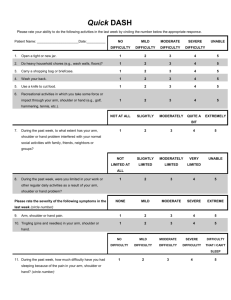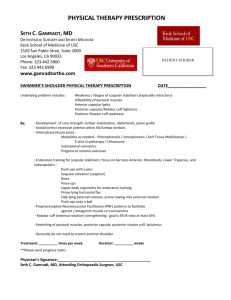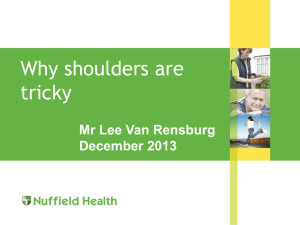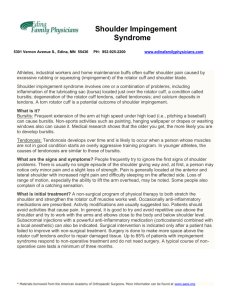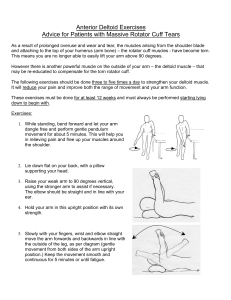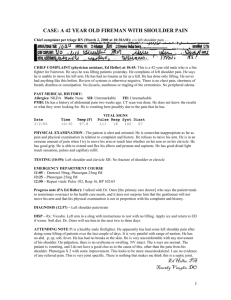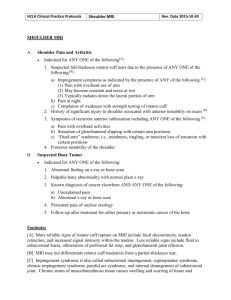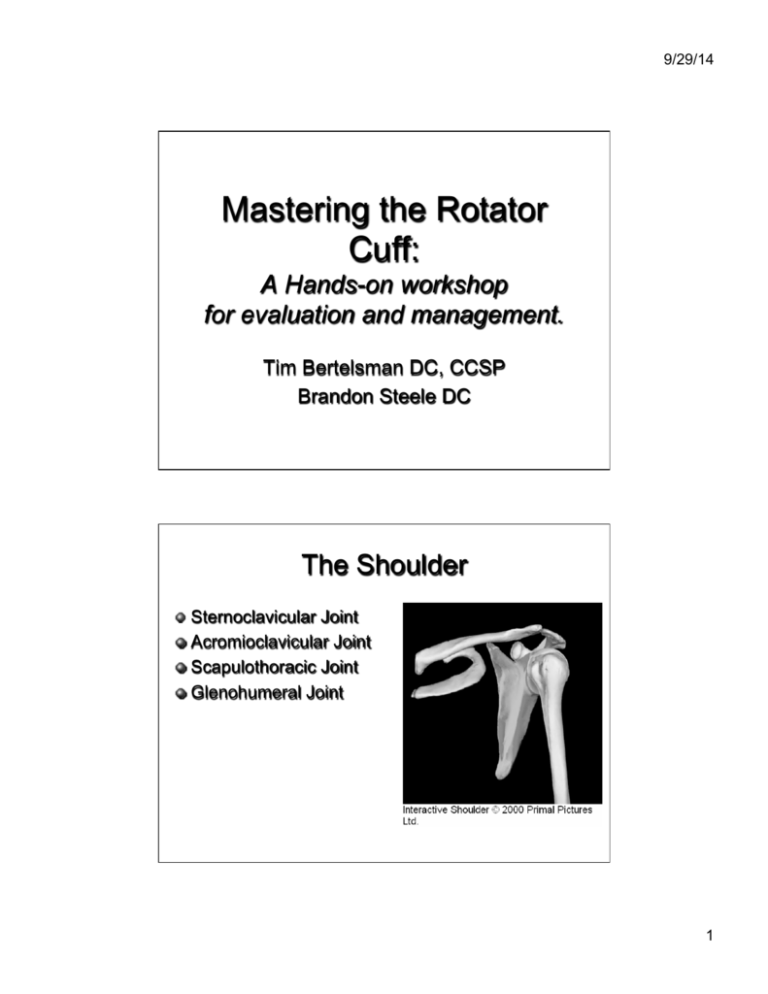
9/29/14
Mastering the Rotator
Cuff:
A Hands-on workshop
for evaluation and management.
Tim Bertelsman DC, CCSP
Brandon Steele DC
The Shoulder
!
!
!
!
Sternoclavicular Joint
Acromioclavicular Joint
Scapulothoracic Joint
Glenohumeral Joint
1
9/29/14
Muscular Anatomy
2
9/29/14
Who do you want Pitching for
You in the World Series?
CUBS fans: The world series is a series of seven games
at the end of the season after the “playoffs”. This
happens every year in the month of October
Muscles
!
!
!
!
Supraspinatus
Infraspinatus
Teres Minor
Subscapularis
3
9/29/14
Kinematics at SC Joint
! Elevation/Depression
! Protraction/Retraction
! Axial Rotation of the Clavicle
SC Elevation/Depression
! How does SC joint motion affect glenohumeral motion?
! What are the effects observed in orthopedic exam?
4
9/29/14
SC Protraction & Retraction
!
Protraction and retraction of the clavicle occur about a vertical axis of rotation.
Do most patients have trouble with Retraction or
Protraction?
Kinematics at AC Joint
5
9/29/14
Upward/Downward Rotation of AC 30˚
!
Upward rotation of the scapula
at the AC joint occurs as the
scapula “swings upwardly and
outwardly”.
!
Complete upward rotation of
the scapula at the AC joint is
considered the close-packed
position. This motion places
significant stretch on the
inferior AC joint capsule and
the coracoclavicular ligament.
!
Downward rotation occurs
upon decent of the arm from
the elevated position.
DeLee, Jesse C., et al. "Osteolysis of the Distal Clavicle". DeLee and
Drez's Orthopaedic Sports Medicine, 3rd Edition. Philadelphia.
Elsevier, Inc. Copyright 2010.
6
9/29/14
Kinematics at the Scapulothoracic
Joint
! Elevation/Depression
! Protraction/Retraction
! Upward Rotation/Downward Rotation
Scapulothoracic Elevation/Depression
Scapular elevation occurs as a composite of SC and AC
joint rotations.
Scapulothoraic Rythem
7
9/29/14
Scapular Elevators/Depressors
Scapulothoracic Protraction/Retraction
! Protraction occurs as a summation of horizontal
plane rotations at both the SC and AC joints.
8
9/29/14
Scapular Protractors
Scapular Retractors
9
9/29/14
Kinematics at the GH Joint
! Abduction/Adduction
! Flexion/Extension
! Internal Rotation/
External Rotation
Glenohumeral Abduction-120˚
! Need AC translation
! SC downward rotation
! ST elevation and posterior tilt.
10
9/29/14
Importance of Roll & Slide Arthokinematics
! Without a sufficient inferior
slide during abduction, the
superior roll of the humeral
head ultimately leads to a
jamming or impingement of
the head against the
coracoacromial arch.
! An adult-sized humeral
head that is rolling up a
glenoid fossa without a
concurrent inferior slide
would translate through the
10mm coracoacromial
space after only 22˚ of
abduction.
Scapular vs. Frontal Plane Abduction
! 35˚ anterior to the frontal
plane is generally a
more functional and
natural movement.
! Internal Rotation of the
arm decreases
Subacromial space due
to the greater tubercle of
the humerus.
11
9/29/14
Glenohumeral Abductors
Glenohumeral Adduction/Adductors
! Look for eccentric control
n
Does the scapula wing (serratus/mid-low trap
weakness
12
9/29/14
Glenohumeral Flexion-120˚/ Extension-50˚
! No Roll and Slide
! However tension in the
inferior
coracohumeral
ligament, posterior
capsule, teres minor, or
infraspinatus will limit
mobility and force anterior/
superior transaltion
Glenohumeral Flexors
13
9/29/14
Glenohumeral Extensors
Glenohumeral Internal Rotation- 75-85˚
14
9/29/14
Glenohumeral External Rotation- 60-70˚
Internal/External GH Rotation
Internal
Impingement
15
9/29/14
The Shoulder Dysfunction
Continuum
!
!
!
!
Scapular Dyskinesis
Anterior Impingement Syndrome
Rotator Cuff Tear
Rotator Cuff Rupture
! Bonus: Subacromial bursitis, Biceps tendinopathy,
Adhesive capsulitis, Degeneration
16
9/29/14
Scapular Dyskinesis
Normal Shoulder Kinetics
17
9/29/14
“SICK” Scapula
! Scapular malposition
! Inferior angle
prominence
! Coracoid tenderness/
malposition
! dysKinesis.
Scapular Dyskinesis (SD)
Tightness:
-Pec
-Biceps (short head)
Weakness:
-Lower trapezius
-Serratus anterior
18
9/29/14
Alternate Causes of SD
Neurologic
Joint Pathology
! Cervical radiculopathy
! Peripheral neuropathy
! Injury to the spinal
accessory nerve, long
thoracic nerve, or
suprascapular nerve
!
!
!
!
!
AC separation
A/C instability
A/C arthrosis
Labral injury
Glenohumeral internal
derangement
! Glenohumeral instability
! Biceps tendinitis
! Prior clavicle or scapula
fracture.
SD Symptoms
! Pain in the anterior or posterosuperior
aspect of the shoulder
! May radiate inferiorly toward the lateral
deltoid or superiorly into the trapezius
region
! Pain over the coracoid (pec minor
tightness)
19
9/29/14
SD Static Assessment
Winging
Lateral scapular slide test
SD Dynamic Assessment
! Limited IR
! Scapulohumeral
rhythm test
! Scapular dyskinesis
test.
20
9/29/14
Shoulder Anterior
Impingement Syndrome
Shoulder Anterior Impingement
Syndrome (SAIS)
21
9/29/14
Diminished Subacromial Space
! Acromioclavicular
degeneration
! Osteophytes
! Thickened
coracoacromial
ligament
! Scapular Dyskinesis
! Upper Crossed
Syndrome
Upper Crossed Syndrome
22
9/29/14
Acromion
Morphology
20% Flat” (type I)
55% “Curved” (type II)
25% “Beaked” (type III)
SAIS
Sport/ Occupation Risks
!
!
!
!
!
!
!
swimming
baseball
volleyball
weightlifting
tennis
rowing
archery
!
!
!
!
!
!
carpenters
electricians
painters
wall paper hangers
cleaning windows
washing/ waxing cars
23
9/29/14
Neer Stages
! Stage I
n younger patients
n acute but reversible pain, swelling and hemorrhage
! Stage II
n middle age patients who have suffered with SAIS for
months or years
n tendonitis and permanent fibrosis
! Stage III
n prolonged irritation that has caused significant tendon
degeneration
n irreversible mechanical disruption of the rotator cuff
tendon
SAIS Symptoms
! Sharp pain during
overhead activity or while
reaching behind the back
to fasten a bra or close a
zipper.
! May develop a constant
ache that is present at
rest.
! Nighttime pain is
common, often disrupting
sleep. Sleeping on the
affected side may
exacerbate pain
24
9/29/14
SAIS Clinical Evaluation
! Scapular Dyskinesis
! Limited & “Painful” ROM
n
n
Forced passive horizontal adduction/ Cross body stretch
“Painful Arc” (60-120 abduction)
! Isolated Strength Tests
n
Supraspinatus (Resisted Abd) Empty can test
! Hawkins-Kennedy test
! Neer test
! Scapular assistance test
SAIS Functional Maneuvers
! Scapular assistance
test
! Scapular retraction
test
! Scapular
repositioning test
25
9/29/14
Rotator Cuff Tendinopathy
…itis …opathy …tear
26
9/29/14
RC Predisposing Factors
! Dyskinesis/
Impingement
! obesity
! hypercholesterolemia
! genetics
! history of
corticosteroid
injection
! smoking
! hypovascularity
Codman’s Critical Zone
27
9/29/14
RC Tear Presentation
Acute
Chronic
! “Tearing” or “snapping”
feeling
! Severe pain and
weakness
! Older patient
! Silent/ slow onset pain
and weakness
! Variable symptoms
! Crepitus
RC Tear Presentation
! Anterolateral shoulder
pain
! Provoked by
overhead activity
! Worse at night
28
9/29/14
QuickDASH
QuickDASH
QuickDASH
Please rate your ability to do the following activities in the last week by circling the number below the appropriate response.
NO
DIFFICULTY
MILD
DIFFICULTY
MODERATE
DIFFICULTY
SEVERE
DIFFICULTY
UNABLE
WORK MODULE (OPTIONAL)
1.
Open a tight or new jar.
1
2
3
4
5
The following questions ask about the impact of your arm, shoulder or hand problem on your ability to work (including
homemaking if that is your main work role).
2.
Do heavy household chores (e.g., wash walls, floors).
1
2
3
4
5
Please indicate what your job/work is:_______________________________________________________________________________________________________________________________________________________________________________________________________________________________________________________________________________________________________________________________________________________________________________
3.
Carry a shopping bag or briefcase.
1
2
3
4
5
4.
Wash your back.
1
2
3
4
5
Please circle the number that best describes your physical ability in the past week.
5.
Use a knife to cut food.
1
2
3
4
5
Did you have any difficulty:
NO
DIFFICULTY
MILD
DIFFICULTY
MODERATE
DIFFICULTY
6.
Recreational activities in which you take some force
or impact through your arm, shoulder or hand
(e.g., golf, hammering, tennis, etc.).
1
2
3
4
5
1.
using your usual technique for your work?
1
2
3
4
5
2.
doing your usual work because of arm,
shoulder or hand pain?
1
2
3
4
5
NOT AT ALL
SLIGHTLY
MODERATELY
3.
doing your work as well as you would like?
1
2
3
4
5
4.
spending your usual amount of time doing your work?
1
2
3
4
5
7.
8.
During the past week, to what extent has your
arm, shoulder or hand problem interfered with
your normal social activities with family, friends,
neighbours or groups?
During the past week, were you limited in your
work or other regular daily activities as a result
of your arm, shoulder or hand problem?
1
2
3
NOT LIMITED
AT ALL
SLIGHTLY
LIMITED
MODERATELY
LIMITED
1
2
3
NONE
MILD
MODERATE
1
2
3
QUITE
A BIT
4
VERY
LIMITED
4
EXTREMELY
❐ I do not work. (You may skip this section.)
SEVERE
DIFFICULTY
UNABLE
5
UNABLE
5
SPORTS/PERFORMING ARTS MODULE (OPTIONAL)
The following questions relate to the impact of your arm, shoulder or hand problem on playing your musical instrument or
sport or both. If you play more than one sport or instrument (or play both), please answer with respect to that activity which is
most important to you.
Please indicate the sport or instrument which is most important to you:________________________________________________________________________________________________________________________________________________________________________________________________________________________________________
Please rate the severity of the following symptoms
in the last week. (circle number)
9.
Arm, shoulder or hand pain.
10. Tingling (pins and needles) in your arm,
shoulder or hand.
1
NO
DIFFICULTY
11. During the past week, how much difficulty have
you had sleeping because of the pain in your arm,
shoulder or hand? (circle number)
2
MILD
DIFFICULTY
2
1
(
)
3
MODERATE
DIFFICULTY
3
SEVERE
4
4
5
5
SO MUCH
SEVERE DIFFICULTY
DIFFICULTY THAT I
CAN’T SLEEP
4
QuickDASH DISABILITY/SYMPTOM SCORE = (sum of n responses) - 1 x 25, where n is equal to the number
n
of completed responses.
A QuickDASH score may not be calculated if there is greater than 1 missing item.
EXTREME
5
❏
I do not play a sport or an instrument. (You may skip this section.)
Please circle the number that best describes your physical ability in the past week.
Did you have any difficulty:
1.
using your usual technique for playing your
instrument or sport?
NO
DIFFICULTY
MILD
DIFFICULTY
MODERATE
DIFFICULTY
1
2
3
SEVERE
DIFFICULTY
4
5
5
UNABLE
2.
playing your musical instrument or sport because
of arm, shoulder or hand pain?
1
2
3
4
3.
playing your musical instrument or sport
as well as you would like?
1
2
3
4
5
4.
spending your usual amount of time
practising or playing your instrument or sport?
1
2
3
4
5
SCORING THE OPTIONAL MODULES: Add up assigned values for each response; divide by
4 (number of items); subtract 1; multiply by 25.
© INSTITUTE FOR WORK & HEALTH 2006. ALL RIGHTS RESERVED
An optional module score may not be calculated if there are any missing items.
Partial vs Full Thickness
Partial Tear
Full Thickness Tear
29
9/29/14
RC Evaluation
!
!
!
!
!
!
SAIS plus:
ROM
Palpation/ Rent sign
Drop arm test
Biceps tendon assessment
Isolated Strength testing
RC Isolated Strength
Assessment
! Supraspinatus (Elevation)
n
Empty can/ Jobe test
! Infraspinatus & Teres Minor (ER)
n
Hornblower’s Sign/ Patte Test
! Subscapularis (IR)
n
n
n
Lift off test
Bear Hug test
Belly Press test
30
9/29/14
Rotator Cuff Differential Dx
! A/C joint injury, A/C or glenohumeral osteoarthritis,
adhesive capsulitis, biceps tendinopathy/rupture, labral
injury, calcific tendonitis, cervical radiculopathy/ referral,
inflammatory arthropathy, avascular necrosis, neoplasm,
suprascapular nerve entrapment, instability, fibromyalgia,
acute bursitis, myofascial pain syndrome, thoracic outlet
syndrome, fracture, infection, and somatovisceral
referral- particularly cardiac.
Biceps Tendinopathy
31
9/29/14
Biceps Tendinopathy
Presentation
! Deep throbbing ache over the anterior shoulder
or bicipital groove
! Pain may refer to the deltoid insertion
! Provoked by repetitive overhead activity and
forearm supination, shoulder flexion, or elbow
flexion
! Symptoms increase when initiating activity
! Nocturnal symptoms are common
Biceps Tendinopathy Evaluation
!
!
!
!
!
!
!
Limited ROM
Tenderness to Palpation
Yergason’s
Speed’s
Bear Hug
Belly Press
Upper Cut test
32
9/29/14
Evaluation
The Shoulder Evaluation:
Patient History
1.
What is the patient’s age
2.
How does the patient support
the arm?
3.
What was the mechanism of
injury, if any?
4.
Are there any movements that
cause the patient pain or
problems?
33
9/29/14
Painful Arc
! The patient reports
pain between 60-120
degrees of active
shoulder abduction.
Pain decreases
above 120 degrees.
This test suggests
shoulder
impingement.
34
9/29/14
Scapular Assistance Test
!
Patient performs active elevation
of their straightened arm, in a
scapular plane, until pain is felt.
This is then compared to
discomfort from the same
maneuver when the clinician
"assists" scapular motion.
Assistance for the second part of
this assessment is performed by
the clinician grasping the patients
scapula and rotating the inferior
angle upward and laterally during
arm elevation. The clinician should
also pull posteriorly on the
superior scapular border.
Impingement related to muscle
imbalance will likely improve with
"assistance".
Scapular Retraction Test
!
This test is a comparison between
unassisted and assisted
movement. First, the patient
abducts their arm in a scapular
plane and notes symptoms. The
patient then repeats this motion
while the clinician assists with
retraction and posterior tilt of the
scapula (pushing the inferior angle
of the scapula toward the spine).
Relief of impingement symptoms
and increased rotator cuff strength
is a positive test, suggesting that
scapular dyskinesis is contributing
to the patient's rotator cuff
impingement symptoms.
35
9/29/14
Scapular Repositioning Test
!
This test is performed with the
patient consciously focusing on
holding their scapula in a
posterior tilted and depressed
position (pushing the inferior
angle of the scapula toward
the spine) while abducting their
arm in a scapular plane. A
positive test results in
improved rotator cuff strength
and decreased impingement
symptoms when compared to
“natural” motion. A positive
test suggests that scapular
dyskinesis is contributing to the
patient's rotator cuff
impingement symptoms.
Hawkins- Kennedy
! Seated patient's arm
placed into 90 degrees of
forward flexion with 90
degrees of elbow flexion.
Clinician stands in front
and stabilizes patients
scapula with one hand
while gradually rotating
patients arm downward,
into internal rotation.
Used to assess for
impingement as well as
the integrity of the rotator
cuff tendons and glenoid
labrum.
36
9/29/14
Neer Test
! Clinician stands behind
patient, stabilizes the
scapula with one hand
and grasps the patients
elbow with the other
hand, moving their
straightened arm into
forward flexion until pain
is reported. Used to
assess for impingement
as well as the integrity of
the rotator cuff tendons
and glenoid labrum.
Empty Can
! Aka Jobe Test Patients
straight arm placed at 90
degrees of elevation and
45 degrees anterior to the
scapular plane. Patient
points thumb down (as to
empty a can). Clinician
stabilizes scapula and
provides downward
pressure on the patients
outstretched arm. Pain or
weakness signifies
possible rotator cuff
pathology involving the
supraspinatus.
37
9/29/14
IRRST Test
!
The patient actively abducts their
shoulder to 90 degrees and
externally rotates (as if to ask a
question). The clinician resists
isometric external rotation then
internal rotation. The test is
considered positive when the
patient exhibits good strength in
external rotation but weakness in
internal rotation, suggesting a
probable non-outlet intra-articular
lesion. A negative test (no
increased weakness upon internal
rotation) is more predictive for
outlet impingement. The test very
effectively differentiates between
intra-articular pathology (SLAP,
instability, RC tear) and outlet
impingement.
Full Can
(Supraspinatus)
! The patient is seated or
standing with the arm
outstretched in the
scapular plane, thumb up.
The clinician applies a
downward force to the
patients arm. Pain or
weakness signifies
possible rotator cuff
pathology involving the
supraspinatus.
38
9/29/14
Horn Blowers Sign
(Infraspinatus/ Teres Minor)
!
Aka Patte Test. The patient’s
elbow is bent to 90 degrees so
that their forearm is pointing
upward, as though they are
holding a horn. The clinician
stabilizes the elbow with one
hand and attempts to rotate
the patient’s arm internally
while the patient resists with an
external rotation counterforce.
Pain or weakness is
suggestive of teres minor
involvement.
Belly Press Test
(Subscapularis)
! Aka Napoleon test. The
standing patient places
their hand on their
abdomen and aligns their
forearm on a frontal plane
(i.e. Napoleon style). The
clinician attempts to lift
the patient’s hand/arm
away from their abdomen
while the patient resists.
Pain or weakness
suggests subscapularis
involvement.
39
9/29/14
Bear Hug Test
(Subscapularis)
! The patient places the
affected hand, palm down
on the unaffected
shoulder. The clinician
attempts to lift the
patient’s hand upward,
off of their shoulder while
the patient resists. Pain
or weakness is
suggestive of
subscapularis muscle
involvement.
Lift Off Test
(Subscapularis)
! The patient is seated or
standing and places their
hand behind their back,
palm facing outward. The
clinician applies
resistance as the patient
attempts to press their
hand away from their
back against that
resistance. Pain or
weakness suggests
involvement of the
subscapularis muscle.
40
9/29/14
Rent Sign
! Palpation reveals
atrophy or retraction
of a muscle/ tendon,
indicating possible
rupture or pathology.
May be seen in the
supraspinatus in
cases of rotator cuff
rupture.
Drop Arm Test
!
The clinician abducts the
patients straightened arm to 90
degrees and asks the patient
to hold that position as the
clinician removes their support.
A positive is noted when the
arm can be passively abducted
by the clinician without pain,
but when support of the arm is
removed and the deltoid
contracts suddenly, pain
causes the patient to hunch
the shoulder and quickly lower
the arm. The drop arm sign is
seen when there is pathology
or a full-thickness tear of the
supraspinatus tendon.
41
9/29/14
Speeds Test
!
The patient is standing with their
arm at 90 degrees of forward
flexion in a sagittal plane, forearm
supinated (arm straight forward,
palm up). The clinician applies a
downward pressure as the patient
resists with eccentric biceps
contraction. The test is repeated
with the patients forearm in
pronation. Pain over the bicipital
groove when performing the test
in supination and decreased
discomfort in pronation suggests
biceps tendon irritation.
Yergason’s Test
!
The patient is seated with their
arm at their side, elbow flexed to
90 degrees, forearm pointing
forward, thumb up. The clinician
grasps the patient’s hand and
applies resistance as the patient
attempts to bring their palm
toward their face (forearm
supination, elbow flexion and
shoulder internal rotation).
Reproduction of pain suggests
biceps tendon or transverse
ligament involvement.
42
9/29/14
Upper Cut Test
!
The patient is seated with their
arm at their side, elbow flexed to
90 degrees, forearm supinated,
fist closed and pointing forward.
The clinician places their hand
over the patient’s fist and applies
resistance as the patient attempts
to “quickly make an uppercut
motion toward chin level”. Pain or
popping suggests biceps tendon
involvement.
RC Radiographic Imaging
43
9/29/14
RC Advanced Imaging
44
9/29/14
Conservative Treatment
Myofascial Release
!
!
!
!
!
!
ART
GRASTON
PIR
IASTM
PIN AND STRETCH
Etc…
45
9/29/14
ADL advice
Avoid:
Try:
! painful overhead activity
! carrying heavy objects
! sleeping on the affected
side
! Ice
! Home rehab exercises
! Aerobic exercise/ weight
loss
! Smoking cessation
Active Rehab
Initial Goals:
1. Achieve Full Range of motion
through all joints of the
shoulder girdle.
-Manipulation
-Mobilzation
-Stretching
2. Achieve Conscious
activation of the scapular
stabilizers.
-Rehabilitation
46
9/29/14
Strengthening
1. Can
only occur after scapular stabilization.
Holmgren T, Bjornsson Hallgren H, Oberg B et al. Effect of specific exercise strategy on need for surgery in patients
with subacromial impingement syndrome: randomised controlled study. BMJ. 2012 Feb 20;344:e787.
Hsu Y, Chen W, et al. The effects of taping on scapular kinematics and muscle performance in baseball players with
shoulder impingement syndrome. Journal of Electromyography and Kinesiology 2009;19:1092-1099
Kaya E, Zinnuroglu M, Tugcu I. Kinesio taping compared to physical therapy modalities for the treatment of shoulder
impingement syndrome. Clincial Rheumatology 2010;30(2):201-207
Thelen M, Dauber J, Stoneman P. The Clinical Efficacy of Kinesio Tape for shoulder Pain: A Randomized Doubleblinded, Clinical Trial. Journal of Orthopaedic & Sports Physical Therapy 2008;38(7):389-395
Bartolozzi A, Andreychik D, Ahmad S: Determinants of outcome in the treatment of rotator cuff disease. Clin Orthop
Relat Res 1994, 308:90-97.
Ainsworth R, Lewis JS. Exercise therapy for the conservative management of full thickness tears of the rotator cuff:
clinical practice a systematic review. Br J Sports Med 2007;41:200-10
2. Focus
should remain on eccentric strengthening
Litchfield R, et al. Progressive stregthening exercises for subacromial impingement syndrome. Clin J Sport Med. 2013
Bernhardsson S, Klintberg IH, Wendt GK. Evaluation of an exercise concept focusing on eccentric strength training of
the rotator cuff for patients with subacromial impingement syndrome. Clin Rehabil. Jan 2011;25(1):69‐78.
Jonsson P, Wahlstrom P, Ohberg L, Alfredson H. Eccentric training in chronic painful impingement syndrome of the
shoulder: results of a pilot study. Knee Surg Sports Traumatol Arthrosc. Jan 2006;14(1):76‐81.
RC Surgery?
! full thickness tears
greater than 1 cm
! symptoms lasting
more than one year
! functional impairment/
weakness
47
9/29/14
Treatment
!
!
!
!
!
Scapular Dyskinesis
Anterior Impingement Syndrome
Biceps Tendinopathy
Rotator Cuff Tear
Rotator Cuff Rupture
Remember To Listen To Your
Patient’s Goals
Scapular Dys. Jack
48
9/29/14
49
9/29/14
Scapular Dyskinesis Phase 1:
YTWL Scapular Depression
Stand with your straight arms raised
above your head in a "Y" position.
Squeeze your shoulder blades
together and downward
throughout the following sequence
of movements. Lower your
straightened arms to shoulder
level, into a "T" position. Next
bend your elbows so that your
fingers are pointing straight up
while slightly lowering your elbows
to make a "W". Finally, while
keeping your elbows bent 90
degrees, lower your arms to your
sides so that your elbows are
touching your ribs to form an "L"
on each side and squeeze. Hold
each position for 1-2 seconds and
repeat 3 sets of 10 repetitions,
twice per day or as directed
Scapular Dyskinesis Phase 1:
Trapezius Stretch
Place your right arm behind your
back and grasp your right wrist
with your left hand. Laterally
flex your neck to move your left
ear toward your left shoulder
as you pull your right arm.
Against the resistance of your
left hand, attempt to shrug your
right shoulder for seven
seconds. Relax and stretch
your right arm downward as
you bend your neck further
toward the left. “Lock in” to
this new position and perform
three contract/relax cycles on
each side twice per day or as
directed.
50
9/29/14
Scapular Dyskinesis Phase 1:
Unilateral Pec Stretch
Stand with your arm straight out at
shoulder level reaching
backwards, thumb up. Position
yourself so that your hand is
against a door frame or post.
Gently turn your body away from
the post, until you feel a gentle
stretch in your chest and shoulder.
Against the resistance of the post
or door frame, attempt to rotate
your arm forward in front of your
body for seven seconds. Relax
and rotate your body away from
the door frame or post to increase
the stretch on your shoulder.
“Lock in” to this new position and
repeat three contract/relax cycles
on each side twice per day or as
directed.
Scapular Dyskinesis Phase 1:
Bilateral Shoulder External Rotation
Stand with your arms at
your side. Bend your
elbows to 90 degrees and
hold an elastic resistance
band in your hands as
shown. Move your hands
outward/ apart while
keeping your elbows
tucked into your body.
Return to the start
position and repeat three
sets of 10 repetitions
daily or as directed by
your doctor.
51
9/29/14
Scapular Dyskinesis Phase 1:
Scapular Protraction
Grasp a dumbbell in each hand.
Begin by lying on your back,
arms straight and reaching
toward the ceiling. Allow your
shoulder blades to lie flat on
the ground. Extend both arms
straight upward, toward the
ceiling, to allow your shoulder
blades to "protract" i.e. move
forward as far as you can. Hold
this contraction 1 second and
return to a resting position.
Repeat 3 sets of 10 repetitions,
twice per day or as directed
Anterior Impingement Phase 1:
YTWL Scapular Depression
Stand with your straight arms raised
above your head in a "Y" position.
Squeeze your shoulder blades
together and downward
throughout the following sequence
of movements. Lower your
straightened arms to shoulder
level, into a "T" position. Next
bend your elbows so that your
fingers are pointing straight up
while slightly lowering your elbows
to make a "W". Finally, while
keeping your elbows bent 90
degrees, lower your arms to your
sides so that your elbows are
touching your ribs to form an "L"
on each side and squeeze. Hold
each position for 1-2 seconds and
repeat 3 sets of 10 repetitions,
twice per day or as directed
52
9/29/14
Anterior Impingement Phase 1:
Glenohumeral Internal Rotation
Begin sitting with good posture.
Place the affected arm behind
your back and reach towards
your opposite hip. Using the
unaffected arm, gently pull the
wrist of your affected arm
further toward your opposite
hip. A stretch should be felt in
the affected shoulder. Pull
gently to the point of tightness
ten times. Each pull should be
slow and stopped if you feel a
sharp pain. This stretch should
be performed for ten
repetitions, once per hour or as
directed.
Anterior Impingement Phase 1:
Codman Pendulum
Lean over a table using the
uninvolved arm for
support as shown. Allow
the involved arm to hang
freely. Use your torso to
swing your involved arm
in a clock-wise circle for
50 repetitions. Repeat in
a counter-clockwise circle
for 50 repetitions.
Perform 50 repetitions in
each direction twice per
day or as directed.
53
9/29/14
Anterior Impingement Phase 1:
Unilateral Pec Stretch
Stand with your arm straight out at
shoulder level reaching
backwards, thumb up. Position
yourself so that your hand is
against a door frame or post.
Gently turn your body away from
the post, until you feel a gentle
stretch in your chest and shoulder.
Against the resistance of the post
or door frame, attempt to rotate
your arm forward in front of your
body for seven seconds. Relax
and rotate your body away from
the door frame or post to increase
the stretch on your shoulder.
“Lock in” to this new position and
repeat three contract/relax cycles
on each side twice per day or as
directed.
Anterior Impingement Phase 1:
Cross Body Stretch
While sitting or standing,
bring your involved arm
across the front of your
upper chest as shown in
the picture. Hold the
affected elbow with your
uninvolved arm and
gently pull across your
chest until a stretch is felt
in the back of your
shoulder. Relax and
stretch the arm further
across your body. Repeat
three stretches, twice per
day or as directed.
54
9/29/14
Biceps Tendinitis Phase 1:
Eccentric Strengthening of the Biceps
!
Begin standing holding a
weight with your palm facing in
at shoulder level. Slowly lower
the weight until your elbow is
straight over a four-second
count. Use your uninvolved
arm to return the weight to the
starting position, and repeat
three sets of 10 repetitions
twice per day or as directed.
Biceps Tendinitis Phase 1:
Biceps Stretch
!
Begin in a standing position
with your arm fully extended
away from your side and your
thumb pointing down. Move
into a position so that the back
of your wrist is against a sturdy
object, like a doorframe or a
post. Gently turn your body
away from your extended arm
until a stretch is felt. Against
the resistance of the
doorframe, attempt to push
your arm forward in front of
your body for seven seconds.
Relax and gently rotate your
body away from the door frame
to increase the stretch.
Perform one set of three
repetitions twice per day or as
directed..
55
9/29/14
Rotator Cuff Syndrome Phase 1:
YTWL Scapular Depression
Stand with your straight arms raised
above your head in a "Y" position.
Squeeze your shoulder blades
together and downward
throughout the following sequence
of movements. Lower your
straightened arms to shoulder
level, into a "T" position. Next
bend your elbows so that your
fingers are pointing straight up
while slightly lowering your elbows
to make a "W". Finally, while
keeping your elbows bent 90
degrees, lower your arms to your
sides so that your elbows are
touching your ribs to form an "L"
on each side and squeeze. Hold
each position for 1-2 seconds and
repeat 3 sets of 10 repetitions,
twice per day or as directed
Rotator Cuff Syndrome Phase 1:
Eccentric Strengthening of the
Supraspinatus
!
Begin standing, holding a
weight with your arm
outstretched at a 45 degree
angle in front of you at
shoulder level. Your thumb
should be pointing down.
Slowly lower the weight to your
thigh at a count of 4 seconds.
Use your “good” arm to
remove the weight from your
hand and return the weight
back to your “affected” hand in
the starting position. Repeat 3
sets of 10 repetitions daily, or
as directed.
56
9/29/14
Rotator Cuff Syndrome Phase 1:
Eccentric Strengthening of the Scapular
Stabilizers
!
Begin in a side lying position
holding a weight, with your arm
outstretched toward the ceiling.
Slowly lower the weight to the
floor at a count of 4 seconds.
Carefully return your arm to the
starting position by keeping it
close to your body. Repeat 3
sets of 10 repetitions daily, or
as directed.
Rotator Cuff Syndrome Phase 1:
Eccentric Strengthening of the Teres Minor
and Infraspinatus
!
Begin in a side lying position
holding a weight with your arm
on your rib cage, elbow bent to
90 degrees, forearm pointing
straight up. While keeping your
arm on your ribs, slowly lower
the weight toward the floor at a
count of 4 seconds. Use your
“good” arm to remove the
weight from your hand and
return the weight back to your
“affected” hand in the starting
position. Repeat 3 sets of 10
repetitions daily, or as directed.
57
9/29/14
PHASE 2 & 3
58


